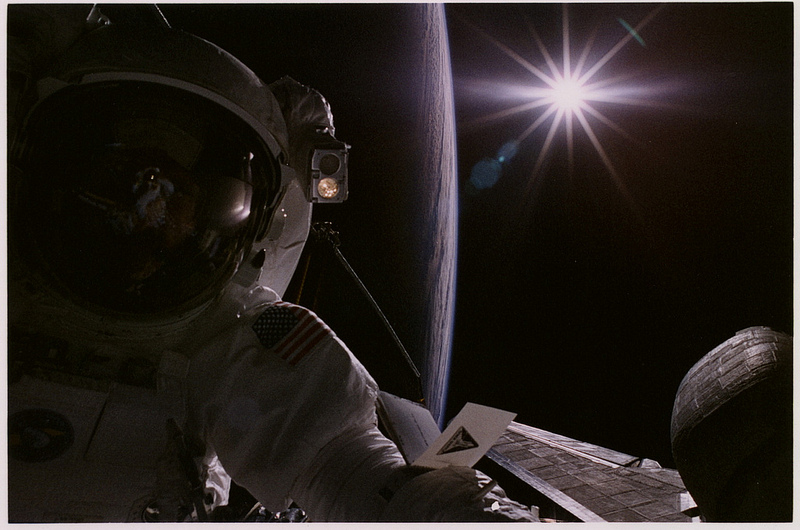
Seventeen years ago this week, NASA launched its second shuttle Servicing Mission (SM-2) to the Hubble Space Telescope (HST). The $1.5 billion observatory has earned itself a well-deserved reputation as one of the most successful space-based instruments ever launched. Across more than two decades of operations, it has peered deeper into the cosmos than ever before, acquiring images of distant galaxies, making breakthroughs in cosmology and physics by accurately determining the rate of expansion of the Universe, detecting planets around far-off stars, witnessing the impact of Comet Shoemaker-Levy 9 into Jupiter, tracking cloud movements in the atmospheres of Uranus and Neptune, and creating the best currently achievable “map” of the surface of Pluto. It is nothing less than a national and international icon, although its early years were marred by a spherical aberration which the STS-61 SM-1 crew triumphantly resolved in December 1993. Three years later, seven more astronaut set off on STS-82 to turn Hubble from a repaired observatory into essentially a brand-new observatory for the 21st century.
“I would think the only other instrument that would rival it in historical value would be Galileo’s original telescope,” said astronaut Steve Hawley, who flew aboard both the initial Hubble deployment mission and aboard STS-82, “when he was able to look at Jupiter and detect the moons and fundamentally change the way we thought about the Universe at that time. I think it’s not unfair to make that sort of comparison. Hubble is revolutionizing how we think about the Universe we live in. I would say it’s almost unrivaled in history.”
At the time of STS-61, the second HST servicing mission was tentatively expected to occur on STS-88 in August 1997, featuring a seven-member crew to support four EVAs on a nine-day flight. Launch of the $260 million mission was subsequently moved earlier on the manifest, finally settling on STS-82 in February 1997, which marked the return to flight of Shuttle Discovery, following a lengthy period of modification and refurbishment in Palmdale, Calif. After arriving on the West Coast of the United States at the end of September 1995, Discovery underwent numerous upgrades, including the installation of the Orbiter Docking System (ODS) for missions to Mir and the International Space Station (ISS). Consequently, she became the first orbiter to have the original airlock removed from her middeck, and a new combined ODS/airlock module was installed in her payload bay. In addition, she received improved payload bay floodlights, new shutters for her star trackers and general inspections, repairs of areas of structural corrosion, and attention to her thermal-protection system. She returned to KSC in June 1996 to begin processing for STS-82.
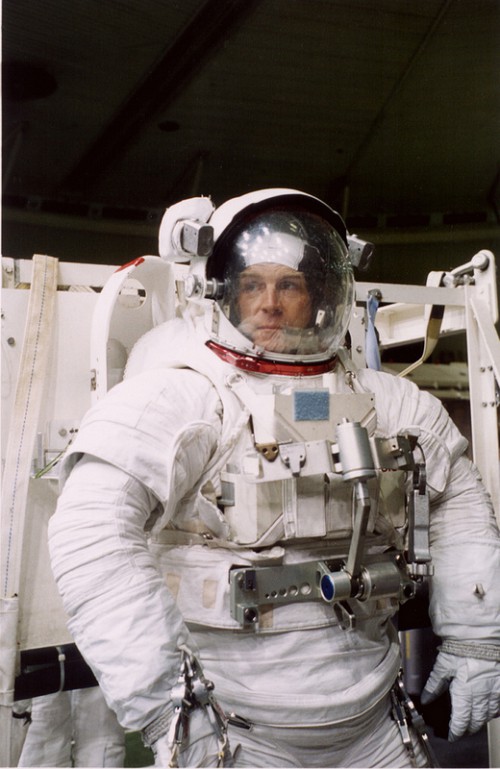
Like the first HST servicing mission, the four spacewalkers for STS-82 were announced some months before the assignment of the commander, pilot, and flight engineer. In May 1995, astronaut Mark Lee, a veteran spacewalker and then-chief of the EVA branch of the astronaut office, was named as the payload commander, with responsibility to oversee the development and planning of four scheduled EVAs. His experience was immense. “Mark had worked Hubble tasks,” recalled Steve Hawley, “back before we deployed Hubble in the first place.”
Under Lee’s direction, the four planned EVAs on STS-82 would install two key pieces of scientific hardware to further enhance HST’s capabilities, both built by Ball Aerospace on behalf of NASA’s Goddard Space Flight Center in Greenbelt, Md. The Space Telescope Imaging Spectrograph (STIS) was designed to replace the earlier Goddard High Resolution Spectrograph (GHRS), which would be removed from Hubble and returned to Earth. (The removal of the GHRS proved timely and fortuitous, for it shut itself down a few days before STS-82 launched, due to an internal electrical problem. A planned observation of Mars was cancelled, but managers decided it was not worth the effort to bring it back to life for just a handful of days.) With a spectral range which spanned the ultraviolet, visible, and near-infrared wavelengths, the $120 million STIS could perform two-dimensional (rather than one-dimensional) spectroscopic “mapping” across planets, stellar nebulae, and entire galaxies and carried the potential to collect 30 times more spectral data and 500 times more spatial data than had previously been possible with HST. This high level of sensitivity was expected to resolve fine details in star formation within distant galaxies, identify supermassive black holes, and investigate the distribution of matter in the Universe by studying quasar absorption lines.
Also to be installed on STS-82 was the Near-Infrared Camera and Multi-Object Spectrometer (NICMOS), which contained three separate cameras and acted as a spectrometer, a coronagraph, and a polarimeter. Like STIS, it featured internal corrective optics to compensate for the effects of the telescope’s spherical aberration. In orbit, the Faint Object Spectrograph (FOS) instrument would be removed from HST and the $100 million NICMOS installed in its place. The new instrument was designed to offer astronomers their first clear view of the Universe at near-infrared wavelengths using HST, thereby permitting studies of celestial objects previously too distant to be directly observed. Of particular interest to NICMOS investigators were brown dwarfs, which emit much of their light in the infrared. In order to attain the low operating temperatures of -355 degree Fahrenheit (-215 degrees Celsius) needed for its observations, the instrument featured a dewar of solid nitrogen and carbon dioxide, which would provide cooling for up to five years.
Although the perception of the public and some sectors of the media regarded SM-2 as “routine,” when compared to STS-61, it was actually one of the most complex shuttle flights ever attempted. The crew would later stress that although the first Hubble servicing mission had removed several “unknowns,” there remained a tremendous amount of stress on their shoulders. “A number of the Orbital Replacement Units were made for [EVA] changeout when they were first designed,” said Mark Lee, “and they are fairly straightforward. Several of the others, though, require use of both hands and they get a little bit more difficult, because you don’t know exactly what to expect. There are a lot of unknowns.” In addition to the announcement of Lee as payload commander in May 1995, three other veteran astronauts were also assigned to join him in supporting the four spacewalks. Joining Lee on EVA-1 and EVA-3 was Steve Smith, whilst Greg Harbaugh and Joe Tanner would perform EVA-2 and EVA-4. Like Lee, Harbaugh was a spacewalking veteran, having performed an EVA on STS-54, whereas Smith and Tanner were both first-time spacewalkers.
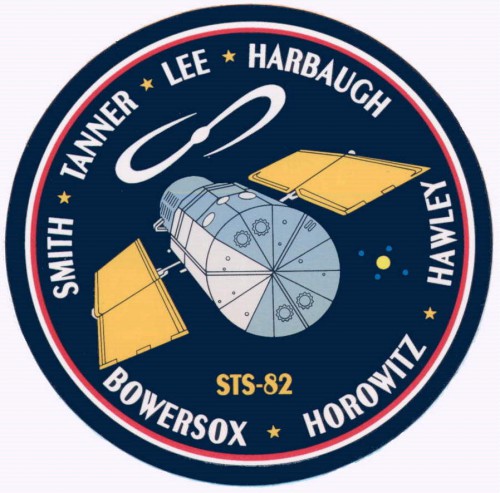
With four scheduled EVAs over four consecutive flight days, early planning foresaw the priority installation of the STIS and NICMOS instruments (each the size of a telephone booth) by Lee and Smith during EVA-1. Next day, Harbaugh and Tanner would venture outside to firstly install a pie-shaped Fine Guidance Sensor (FGS) to replace one of three existing devices, which was showing signs of mechanical wear. Positioned at 90-degree intervals around HST’s circumference, these sensors provided accurate pointing (to within 0.01 arc-seconds) toward desired astronomical targets, then held those targets in the field of view for observation. Additionally, the FGS were used for helping to determine the precise positions and motions of stars and other celestial objects, a field known as “astrometry.” Following the FGS replacement, Harbaugh and Tanner would install a new Engineering/Science Tape Recorder (ESTR), replacing one of three units which stored data aboard the telescope whilst out of scheduled communication with the ground. Finally on EVA-2, they would fit an Optics Control Electronics Enhancement Kit (OCEK), which took the form of a cable to re-route signals to send commands through the Optical Control Electronics box to move the new adjustable mirror inside the FGS.
Lee and Smith would then venture outside for EVA-3 to replace another piece of HST’s pointing system, known as a Reaction Wheel Assembly (RWA), together with one of four Data Interface Units (DIUs), which provided command and data interfaces between the data-management system and the telescope’s subsystems. They would also remove a second ESTR and install a device known as a Solid State Recorder (SSR). Whereas HST previously stored its data on tape, the SSR had no reels or moving parts, which reduced the likelihood of wear, and its capacity was also 10 times larger. It was intended that, after STS-82, the capacity and flexibility of the SSR would be utilised exclusively for scientific data, thus better accommodating the higher data rates of STIS and NICMOS. Finally, on EVA-4, Harbaugh and Tanner would replace one of two Solar Array Drive Electronics (SADE); built by ESA, it served to position HST’s twin solar arrays. One SADE had been removed and replaced by the STS-61 crew. The removed unit was returned to Earth, refurbished to correct problems which had caused transistor failures, and launched aboard STS-82 to replace the second SADE. Finally, the spacewalkers would install Magnetic Sensing System (MSS) protective covers over key hardware to replace material which had degraded in the harsh atomic oxygen environment of low-Earth orbit. In the aftermath of the mission, a standard Servicing Mission Orbital Verification (SMOV) of the enhancements and new hardware—lasting 8-10 weeks—was scheduled to take place, before HST returned to full science operations.
“Although the various servicing tasks are prioritized,” NASA explained, “they have been designed to take into account the possibility that crew members may encounter unforeseen difficulties either in tasks or equipment that could change the pre-planned schedule of installation of various equipment components.” It therefore made sense for Lee, Smith, Harbaugh, and Tanner to cross-train on all of their assigned tasks, and it also required no fewer than three space suit upper torsos and four lower torsos to be housed aboard Discovery for the mission. As the chief spacewalker (“EV1”), Lee would wear red stripes around the legs of his suit for identification, whilst Smith (EV2) was clad in a pure-white suit. The other two spacewalkers would carry slightly different patterns of red stripes: Harbaugh (EV3) carried a broken red stripe on the legs of his suit, whilst Tanner (EV4) had red-and-white diagonal hash lines on his suit. Smith and Tanner shared the upper torso of the third suit, but each had his own lower portion, complete with identification markings.
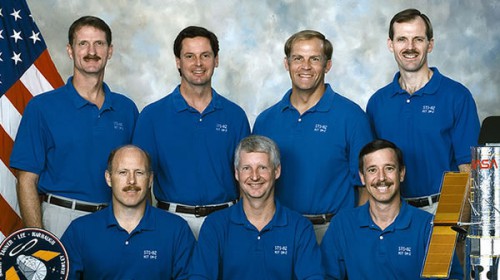
It came as something of a surprise to the spacewalkers from the first HST servicing mission that none of them would be carried over from SM-1 onto SM-2. “Working on STS-82 seemed like an obvious thing to do, to transfer knowledge to the next Hubble crew,” recalled SM-1 veteran Jeff Hoffman in a NASA oral history. However, when his crew returned to Earth in December 1993, the EVA team was told, in no uncertain terms, that other astronauts would be given a chance on future HST missions. Nonetheless, Hoffman participated in several training exercises in the water tank with the STS-82 spacewalkers and later worked as the Capcom in Mission Control during their EVAs. “I think I was able to pass on a lot of information,” he said. “I was basically the backup crew. In case one of them got sick, then I would have gone. Backup crews almost never fly, so that didn’t happen, but it certainly made sense.”
Joining Hoffman at the Capcom’s console during STS-82 were Canadian astronauts Marc Garneau and Chris Hadfield. Since the 50-foot (15-meter) Canadian-built Remote Manipulator System (RMS) mechanical arm was a critical element of each of the Hubble servicing missions, Hoffman found “interesting” notes from Garneau and Hadfield whenever he arrived on console at each Capcom shift changeover. “In each case, their notes were not all about the things that had been done by the EVA crew,” Hoffman recalled, “but all the great things that the Canada arm had accomplished on the previous shift!” In fact, the importance of the RMS demanded that an experienced astronaut-operator was assigned to take control of it for the retrieval of HST, together with supporting the spacewalkers and deploying the telescope back into orbit.
By the beginning of 1996, with a little more than a year remaining before launch, the time came to assign the remainder of the STS-82 crew. Ken Bowersox, who had served as pilot of SM-1, was named as the mission commander, with fellow astronaut Scott “Doc” Horowitz as pilot. The Mission Specialist Two seat would be taken by Steve Hawley, who would serve as the RMS operator and the flight engineer for ascent and re-entry. He had been responsible for the deployment of Hubble on STS-31 in April 1990.
After STS-31, Hawley had left the astronaut corps to accept a position with NASA’s Ames Research Center in Moffett Field, Calif., but returned to the Johnson Space Center (JSC) in Houston, Texas, in August 1992 as deputy director of Flight Crew Operations. His immediate boss was former astronaut Dave Leestma. Early in 1996, Leestma asked Hawley if he wanted to fly again on SM-2. “When I left to go to Ames, I expected that I would never fly again,” Hawley admitted later, “and when I got back from Ames, I expected I would never fly again, except knowing that … there could be some chance that there’d be that opportunity if the right situation came along. But I remember thinking that it’s not the sort of thing that it’s appropriate for me in this job to lobby for.” Leestma explained that the high-profile SM-2 flight required an experienced RMS operator, with advanced knowledge of HST. Hawley went home to talk to his wife and, with her blessing, returned to Leestma to accept the assignment. By early March, Bowersox, Horowitz, and Hawley joined Lee, Smith, Harbaugh, and Tanner to begin full-time training for the mission.
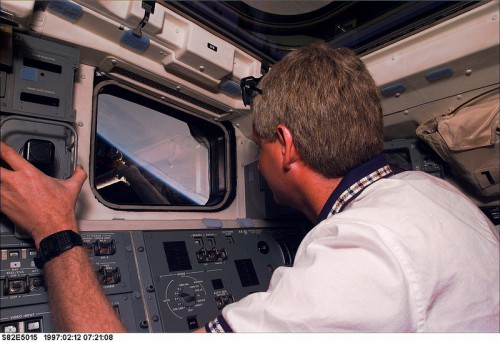
“For a robot arm operator, there’s probably no greater task—no more rewarding task—than to do what we call a ‘track-and-capture’,” Hawley told the NASA oral historian. “When I deployed Hubble [on STS-31] … I picked it up out of the payload bay and let it go. It’s a little different to go capture a free-floating object and to berth it and to move EVA guys around on the end of the arm. That’s about as challenging as it gets in the robot arm world. Having been through dealing with Hubble once before, and knowing the dynamics of the big telescope on the end of the arm, knowing what to expect once you capture it, all that was helpful, so maybe I didn’t feel as intimidated as I might have had that been my first experience with a large payload like that.”
Training required the crew to spend a great deal of time in the water tanks of the 40-feet-deep (12-meter) Neutral Buoyancy Simulator (NBS) at the Marshall Space Flight Center in Huntsville, Ala., and the 25-feet-deep (7.6-meter) Weightless Environment Training Facility (WET-F) at JSC. The construction of a large Neutral Buoyancy Laboratory (NBL) had begun in April 1995 at JSC, primarily to support EVA preparations for ISS assembly tasks, and, according to Hawley, STS-82 was the final shuttle mission to use Marshall’s NBS. The NBL was formally transferred to NASA ownership upon its completion in December 1996, just a few weeks before the launch of STS-82. Measuring 200 feet (62 meters) long, 100 feet (31 meters) wide, and 40 feet (12 meters) deep, and filled with 5.1 million gallons (23.5 million liters) of water, it represented the first NASA facility to be specifically engineered for the neutral buoyancy training of spacewalkers. “I didn’t get much time in the NBL,” Hawley said, “because we only had about a month before we launched.”
The training in the NBS tank, however, was highly realistic because the astronauts could operate in an “integrated” manner with both the spacewalkers and the RMS. “You actually had the real space-suited crewmember on a real arm,” Hawley recalled. “It’s underwater, but you can actually maneuver him around. The experience was extremely valuable to learn the task that he had to do and the task that I had to do and learn how to communicate back and forth. In fact, we got to where you could run each EVA day pretty much end-to-end, as it would really work, with quite high fidelity.” It contrasted sharply with Hawley’s earlier STS-31 training, when the simulators depicted only computerized images of the telescope and the RMS and even HST itself was modeled with a large balloon, whose dynamic motions tended to lack realism.
To enable the multitude of servicing tasks, the STS-82 crew carried numerous tools and aids with them into orbit, which included handrails and handholds, transfer equipment, protective covers, tethers, grapple and stowage fixtures, and foot restraints. A 17-inch (43-cm) titanium-aluminum Power Ratchet Tool, powered by a 28-volt battery, was designed for tasks requiring controlled torque, speed, or turns and could be used in cases where right-angle access to HST components was required. The Multisetting Torque Limiter was used in conjunction with the power tools and hand tools which interfaced with bolts or latches and was designed to prevent damage caused by the application of torque, whilst NASA’s new Pistol Grip Tool fulfilled a key recommendation from the SM-1 crew, who highlighted the need for a smaller, more efficient piece of equipment for very precise tasks. Computer-controlled, battery-powered, and hand-held, the tool could be programmed to control limits for torque, speed, and number of turns.
All told, and when including spares of the tools and various connectors, adjustable extensions, and sockets, the STS-82 crew rose into orbit in February 1997 with more than 300 discrete pieces of equipment to service HST. Their efforts would transform the telescope from a 1970s-era spacecraft, with 1980s optics, into a vehicle for the 21st century with instrumentation which promised to revolutionize astronomy.
The second part of this article will appear tomorrow.
Want to keep up-to-date with all things space? Be sure to “Like” AmericaSpace on Facebook and follow us on Twitter: @AmericaSpace



